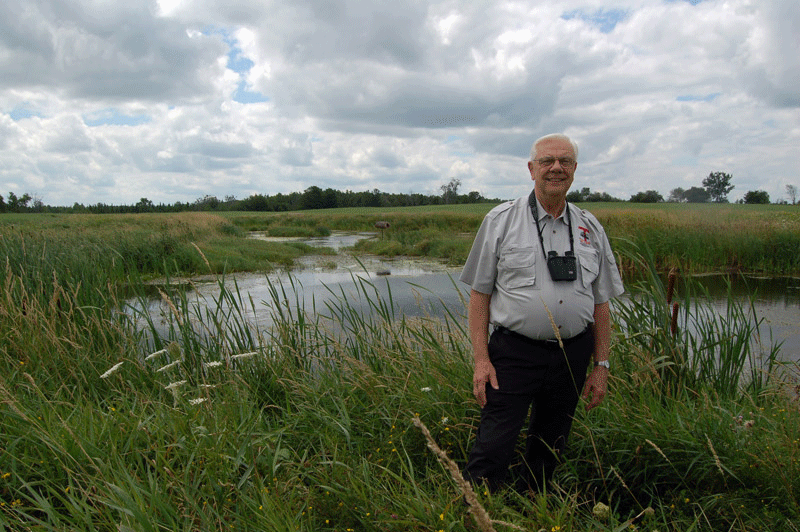Wetland restoration
THE FARMER’S ROLE
KEN ROSIN HASN’T actively farmed for years, but at 73 years of age he still can’t bring himself to let go of farming completely. The 230 acre farm he owns in Amaranth Township is mostly managed by a tenant now, but the wetlands are still his domain.
PHOTO: KEN ROSIN ENJOYS WATCHING THE WILDLIFE ON HIS RESTORED WETLANDS.

Rosin grew up on a family farm in Wisconsin and was always an avid hunter, which naturally lead him to become affiliated with Ducks Unlimited Canada. By 2007, Rosin was seriously talking to the organization about restoring some of the drained wetlands on his property.
“On a drier year you might get pretty close, but you couldn’t really farm all of it,” says Rosin. Since it was only good for farming one in every three years, he decided that restoring the natural wetland was a better use of the land. But the process was slow going at first.
“Half of my property is in the Grand Valley Conservation Area and the other part is in the Nottawasaga Conservation Area,” explains Rosin. “The permit process seemed to take a long time and I was very appreciative of the fact the Ducks Unlimited people had the patience and persistence to get it to happen.”
GETTING STARTED
In 2009, the first four ponds went in. Rosin notes three of those only required a water regulator and a few strategic berms while the other was a complete excavation.
“It was an immediate success,” he recalls. “By that fall we had hundreds of ducks out on these ponds that we had never seen in other years, even though there’s a 20 acre beaver pond marsh on the adjoining property.”
Two more ponds went in the very next year and Rosin had finally taken advantage of all the opportunities his land could offer by 2012. Now he has eight ponds to visit the three or four days he spends out on the farm. He says he has only gone on one successful duck hunt in all that time, finding he is now more interested in taking his binoculars out for the day.
Sean Rootham of Ducks Unlimited says the organization is always looking for people like Ken who they can work with on wildlife habitat creation. Finding and engaging these people inspired a workshop series this year.
The first evening was run in partnership with the Nottawasaga Valley Conservation Authority (NVCA) in July and was such a success that Ducks Unlimited partnered with the Severn Sound Environmental Association, Scales Nature Park, the Wye Marsh Wildlife Centre, and Lake Simcoe Conservation Authority to offer another workshop series in November.
Rootham says it is all part of a three-year endeavour to implement at least 23 new wetland projects in the area, if they can find the right conditions for them.
“Old wetlands that have been previously drained, are excellent spots for doing restoration work,” says Rootham. “You might have swales across your landscape that can be turned into wetland or an old livestock pond that you want to convert. A landowner understands the landscape and what can be done to improve it.”
COST RECOVERY
Rootham says that although the projects do incur some cost to the landowner, there is grant funding available to offset that cost depending on the project. For example, in these three particular watersheds, a wetland restoration that simply requires a little berm work around a natural wetspot could be eligible for 90% coverage. Because funding is so site specific, Rootham says it is best to call Ducks Unlimited or the local conservation authority out to the farm to take a good look.
Fred Dobbs is with the NVCA and he says that for some of the projects he is currently working on the farmers’ share was covered by the use of machinery and in-kind labour.
With a farm background himself, Dobbs is quite adept at explaining project objectives so that the landowner can become a valued contributor in the whole process, rather than a sideline observer.
“I find that biologists often do a lot of the same things farmers do but we don’t often communicate it that way,” says Dobbs.
For instance, farmers are experts at taking a source of nutrients or fertilizer, applying it to a seed bed with the intent of producing a target crop, and preventing those nutrients from being consumed by non-target crops or weeds.
“Biologists don’t apply nutrients, but we do inherit nutrients from the watershed,” he says, “and we manage stream habitat to allow those nutrients to translate into our target crop which may be the right kind of bugs, fish, or birds as opposed to corn, soybeans, or wheat.”
Dobbs finds farmers who understand this concept can see algae growth as weeds, which rob the system of nutrients needed elsewhere. With phosphorous loading such a wide spread problem, an increase in the number of properly functioning wetlands will offer much needed nutrient filtration systems.
“We’ve done research in Lake Simcoe that showed wetlands can remove up to 3.5 kg/hectare of phosphorous annually,” says Rootham.
He is not interested in whether or not no- till practices have contributed to those phosphorous loads. Both Rootham and Dobbs say their organizations are more interested in finding solutions to the problem than nit-picking farm practices. Rosin offers his own living testament, saying his ponds are all completely algae free and no-till is a regular practice on his farm.
“When Ducks Unlimited designs these ponds, they maintain a 10 metre buffer area that’s all seeded down with various kinds of grass seed and clover,” says Rosin. “Anything that might run in there is pretty well filtered before even getting to the ponds.”
Rosin was honoured in 2012 as a Grand River Watershed Award recipient, for excellence in environmental stewardship. •






















